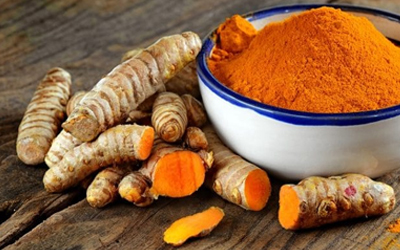
Zingiberaceae is a native of India and Turmeric is a perennial herb with pulpy, orange, tuberous roots that grow to about two feet in length. The aerial parts, which reach three feet, include large, lily-like leaves, a thick, squat, central flower spike, and funnel-shaped yellow flowers.
The active constituent is curcumin. It has been shown to have a wide range of therapeutic effects. First, it protects against free radical damage because it is a strong antioxidant. It reduces inflammation. It accomplishes this by reducing histamine levels and by increasing production of natural cortisone by the adrenal glands. It protects the liver from a number of toxic compounds.
It has been shown to reduce platelets from clumping together, which in turn, improves circulation and helps protect against atherosclerosis. Numerous studies have also shown cancer-preventing effects of curcumin. This may be due to its powerful antioxidant activity in the body. As a powerful antioxidant it has shown greater effects in preventing free radical damage compared to vitamin C, vitamin E and superoxide dismutase.

Many studies on turmeric have revealed that the herb contains cholagogue-type substances, which increase the secretion of bile. Principal among these substances is curcumin, which also possesses liver protective activity, detoxifying dangerous carcinogens, stimulating the gall bladder and acting as a free-radical scavenger. Curcumin has cholekinotic activity (bile duct stimulation).
It has been suggested that turmeric lowers blood cholesterol through these various choleric effects. Turmerics effect on weight loss may also be mediated through curcumins catabolic and metabolic activities on fats. Studies have also revealed that curcumin has anti-inflammatory properties, inhibiting platelet aggregation and cyclooxgenase and lipoxygenase enzymes which catalyze the formation of inflammatory prostaglandins and molecules. Curcumin requires the presence of the adrenal glands to have this non-steroidal anti-inflammatory activity.
Turmeric is a very important herb in Ayurvedic medicine. A symbol of prosperity, it was considered a cleansing herb for the whole body. Medically, it was used as a digestive aid and treatment for fever, infections, dysentery, arthritis and jaundice and other liver problems.
Traditional Chinese physicians used turmeric to treat liver and gallbladder problems, stop bleeding, and treat chest congestion and menstrual discomforts. Turmeric has long been considered an essential flavoring spice of Indian and other ethnic cuisines.
Turmeric provides the typical yellow color of may curry dishes and helps to render food more digestible. Turmeric along with other curry herbs has several physiologic activities, including the inhibition of platelet aggregation antibiotic effects, anticholesteral action and fibrinlytic activity.
Action: Alterative, anthelmintic, Antibacterial, antibiotic, aromatic, carminative, stimulant, tonic, vulnerary
Amenorrhea, anemia, arthritis, blood purifier, blood tissue formation, circulation, cooking spice, cough, diabetes, worms, jaundice, eye problems, fevers, gas, hemorrhoids, edema, indigestion, ligament stretching, metabolism regulator; mucus relief, and hysteria (from inhaling fumes); pharyngitis, protein digesting, skin disorders, abscess, urinary diseases, wound and bruise healer; a natural antibiotic which also improves intestinal flora; inflammatory bowel syndrome (e.g., ulcerative colitis), Chron's Disease, chronic hepatitis, chronic bronchial asthma, psoriasis, all inflammatory conditions. External-acne, insect bites, sore eyes, with honey or aloe gel for bruises or sprains.
In India, turmeric is used for the treatment of anorexia, liver disorders, cough, diabetic wounds, rheumatism, and sinusitis. It is currently being evaluated for its anticarcinogenic and antimutagenic properties.
Sprinkle a bit of turmeric on cuts and scrapes after they have been thoroughly washed. The turmeric, with its antibacterial action, will prevent the bacterial wound infections.
Turmeric helps stimulate the flow of bile, which helps digest fats.
Turmeric fights protozoans in laboratory tests, supporting its traditional use in treating dysentery.
Curcumin has a protective effect on liver tissue exposed to liver damaging drugs. It had been traditionally used for liver ailments. Consuming alcohol regularly or using the pain killer acetaminophen (Tylenol) tends to increase the risk for liver damage; turmeric may help in minimizing this damage to some extent.
Turmerics anti-inflammatory action helps relieve wound inflammation and in treating arthritis.
Studies have shown that turmeric may help reduce cholesterol. It is also shown to prevent the internal blood clots that trigger heart attack and some strokes.
Recent studies show promising results on the use of turmeric to treat cancer. It is believed to inhibit the growth of lymphoma tumor cells. Another study has shown that turmeric helps prevent tumor development in animals.
Hepatitis, indigestion, gall bladder or liver disease, bile duct problems, obesity, arthritis, as a cholagogue, as an anti-inflammatory, as a heptoprotective, as a gallbladder tonic, as a cancer preventive. Toxicity, Cautions & Contraindications: Not known
Collection of raw material in proper season from various regions of India. Authentication and Standardization of botanical species carried out respectively.
Our organization adopted USP based methods for extraction to maintain quality, safety & efficacy of our product by following GMP. For enrichment of herbal extract we optimized & monitored critical process parameters to achieve desire end product which conserve its natural aroma and taste to satisfy consumers need. Product is processed & stored under strictly hygienic production environment.
Phyto Life Science is always taking consideration of consumer’s requirement by providing them versatile products with below unique features:
Powder, Liquid and Oil soluble version also available
Store at cool and dry place
Important Note :-The information presented in this is for informational, reference and educational purposes only and should not be interpreted as a substitute for diagnosis and treatment by a health care professional. Although, the information presented about product is based on material provided by researchers and sources deemed reliable, we do not presume to give medical advice. The information presented here is the base on various Ayurveda & other book references and some market literatures and books and published papers. Anyone wishing to use this information should share it with his or her health care provider before embarking on any therapeutic program. It is your responsibility to discuss any alternative or natural remedy with your health care provider before use.